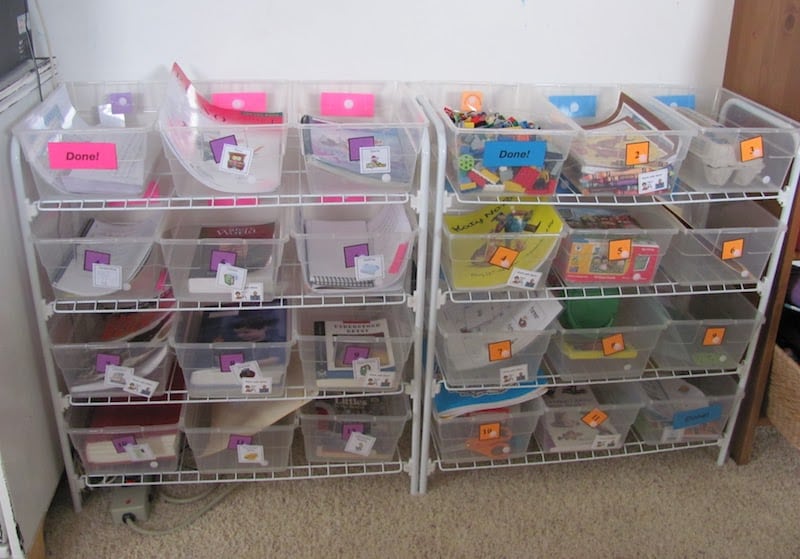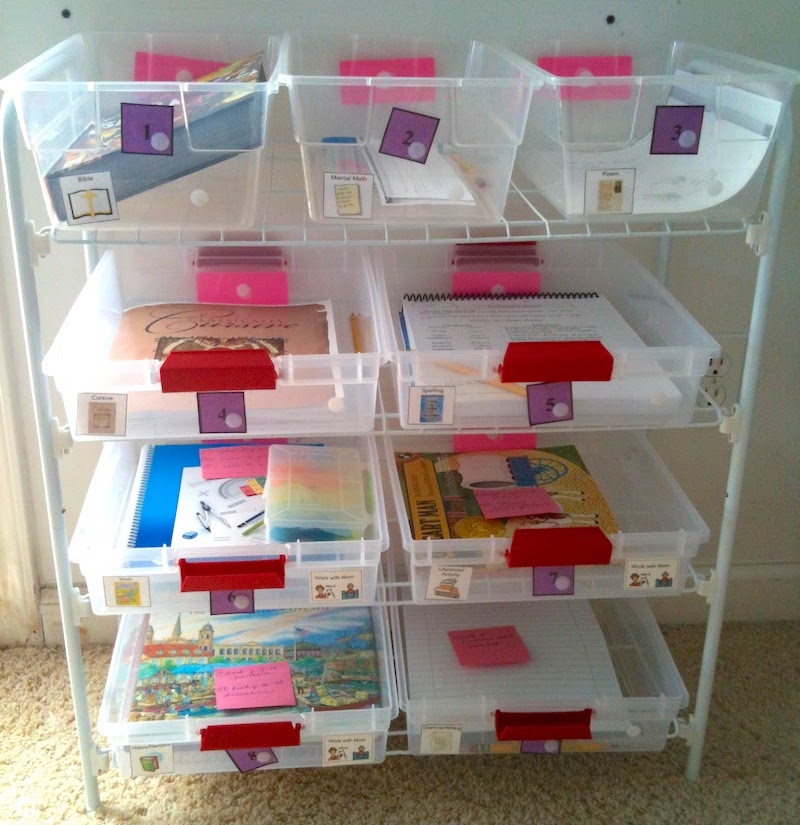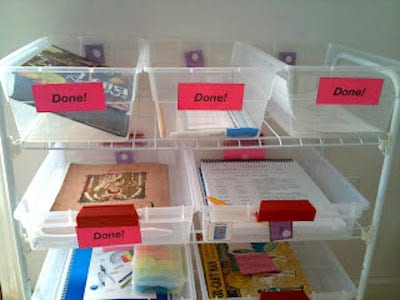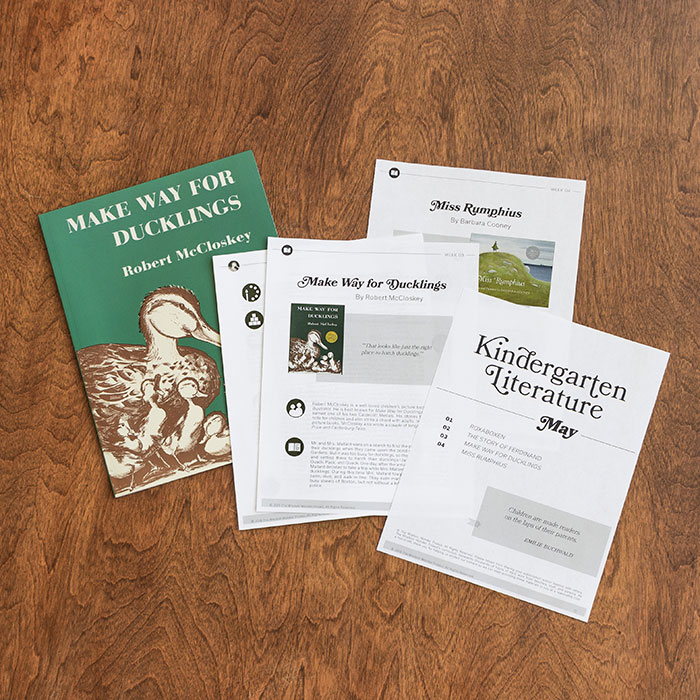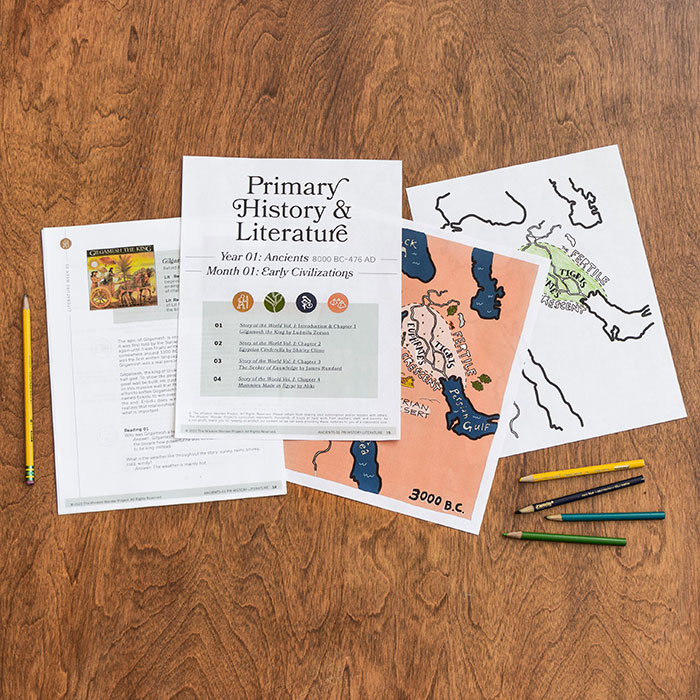If you are trying to juggle multiple assignments, keep the kids focused, and promote independence while keeping toddlers and preschoolers happy, read on! This may be a system you want to try now, or think about for next year. Even if you don’t have littles, this system can help kids of any age get organized and stay motivated.
Have you heard of The Workbox System? This versatile organizational system, developed by a homeschooling mom named Sue Patrick, promotes independence, focus, and learning. It’s been a while since it was popular in the homeschooling world, but the “Workbox Craze” swept through my community a few years back—many of us implemented some form of it in our homes. As one of the eager moms with young children who tried it, I can attest to the life-changing effect it had on our home days! More on that later…
Today I want to share a couple of parent testimonials about using workboxes. In a nutshell, you use containers to break down your day of homeschool assignments into small chunks. Kids know exactly what needs to be done each day, how much work is left, when they need their parent and when they can work independently, and they have everything they need in each box to complete that task.
First, here’s my own take on the Workbox System, written 9 years ago:
I started using the workbox system in January of 2011, after hearing about it the previous summer. We had had a rough fall trying to “get it all done” while enjoying the learning process and maintaining some level of sanity. It wasn’t happening. I was homeschooling a 5th grader, a 1st grader and a rambunctious 4 year old. One daughter was constantly distracted and never knew what she was supposed to be doing, the other daughter complained about her work and wanted to play all day, and the youngest (who hates to be alone), wanted to be in the middle of whatever we were doing, while jumping off of the furniture and singing at full volume. I was ready to try anything to help us get organized, stay motivated, and simplify our school day.
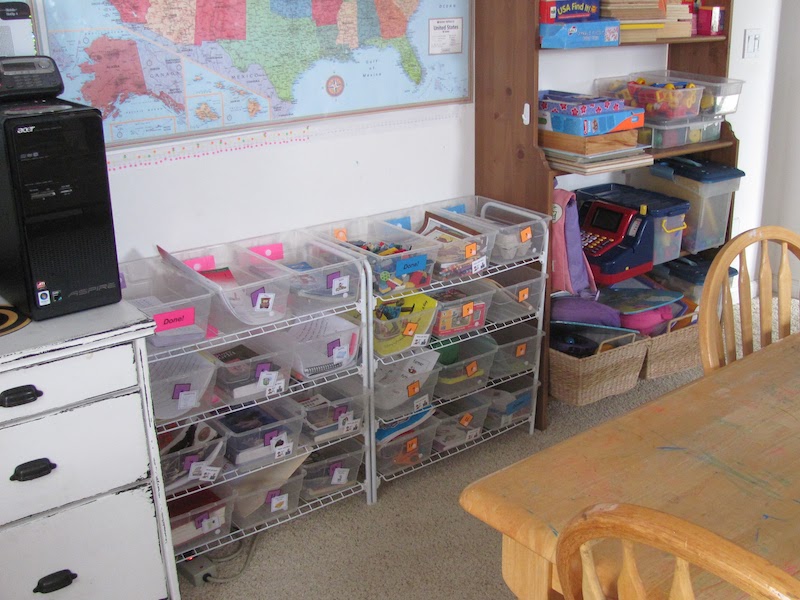 It was a remarkably easy transition to implement workboxes, and all three kids took to it beautifully. My oldest keeps her boxes in her bedroom, next to her desk, since she does most of her work independently and likes a quiet space. The other two have theirs in the school room where they can work with me. Now that we are using them, my oldest can easily see what she needs to accomplish for the day and when she is finished. No more wandering around the house forgetting what’s next. My other daughter gets a break after each row of boxes to play for 10 minutes, which is enough motivation for her to complete those 3 boxes with a good attitude. She also loves knowing when she’s done for the day, and enjoys looking forward to some fun activities that may be ahead in one of the boxes. The biggest improvement of all has been with my 4 year old, who now has his own set of boxes and school work that he can complete either with me or on his own (I give him some of each). He can still be in the same room with us, but is busily engaged most of the time, instead of distracting me and his sisters. He is learning the routine of completing tasks, and enjoying learning.
It was a remarkably easy transition to implement workboxes, and all three kids took to it beautifully. My oldest keeps her boxes in her bedroom, next to her desk, since she does most of her work independently and likes a quiet space. The other two have theirs in the school room where they can work with me. Now that we are using them, my oldest can easily see what she needs to accomplish for the day and when she is finished. No more wandering around the house forgetting what’s next. My other daughter gets a break after each row of boxes to play for 10 minutes, which is enough motivation for her to complete those 3 boxes with a good attitude. She also loves knowing when she’s done for the day, and enjoys looking forward to some fun activities that may be ahead in one of the boxes. The biggest improvement of all has been with my 4 year old, who now has his own set of boxes and school work that he can complete either with me or on his own (I give him some of each). He can still be in the same room with us, but is busily engaged most of the time, instead of distracting me and his sisters. He is learning the routine of completing tasks, and enjoying learning.
It’s so versatile, those who are creative could really have fun thinking of things to include in the boxes. The time to prep the boxes the night before is well worth it, because our homeschool days are much smoother and more peaceful. My mental strain is greatly reduced—I don’t have to juggle everyone’s grids in my mind because everything is laid out for the day, ready to go. Even when we have an interruption in our day, it’s so much easier to get back on track. We still have our occasional grumpy days and bad attitudes (mom included), but there is a great peace of mind that this system has brought to our homeschooling experience. It has given me a lot more confidence going into this next school year, and I love it!
The following year, I posted this update:
Our family has made several small workbox modifications to fit the way we do things, and as we start fresh this fall, we slightly revised our workbox system again to address one common complaint: the traditional boxes are too narrow to fit some of the books, resulting in that unsightly bend in paperbacks, or difficulty fitting larger hardback books. While I did keep one row of narrow boxes (for those subjects that don’t require a large book), I replaced the others with 2 shallower, wider boxes in each row.
The wide boxes fit perfectly and can hold much larger books flat, as well as plenty of math manipulatives or other bulky activities. Although I can now only fit 9 boxes instead of 12 on the rack, I have found that 9 is sufficient for all of the subjects requiring books or items in a box. (As explained in her book, Sue Patrick uses a workbox schedule strip to guide students through their day for both workbox and non-workbox tasks.)
One other modification we use, for those who are new to workboxes: instead of emptying each box into a large tote when they are finished, my kids simply turn each box around to show the “Done!” cards that I placed on the back side of each box. This saves space, and saves me time later since all I need to do is turn the boxes back around instead of fishing them out of a bin and reorganizing them.
A fellow home educator, Jill Talley, also shared about her workbox experience and modifications she implemented back in 2011:
I had heard about Sue Patrick’s Workbox System from a number of moms and went to a Workbox System workshop last year to get a feel for it. After hearing from other moms and seeing how the system works, I did a quick read of Sue Patrick’s Workbox System book and felt like this was something I needed to implement. I needed help staying ahead on my homeschool days and I knew that organizationally the home days were not going to get easier on their own.
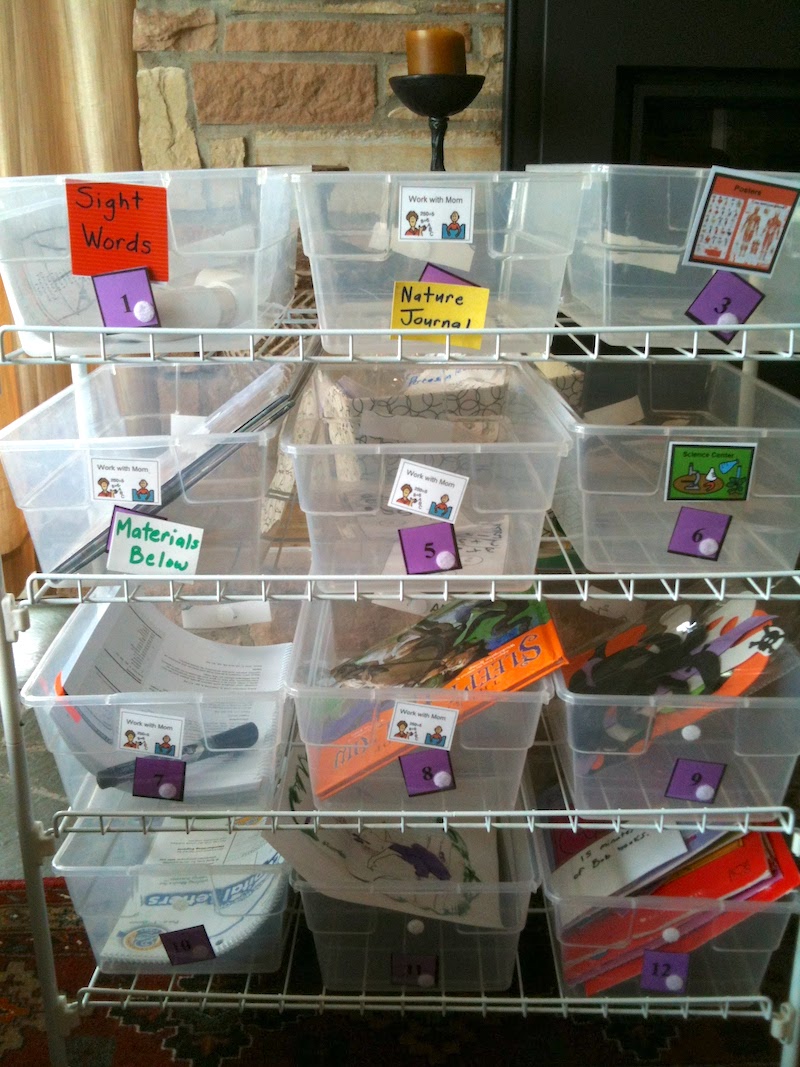 Fast forward to today, I have implemented a lot of what Sue writes about in the books. For example, we do the Posters, the Science Centers, and I make sure my kids know that those “I Need Help” cards are very valuable (I tell the kids they are like a wild card in a card game) and to be used only when they cannot move forward with their work. However, one area where I’ve actually added a lot is how I communicate to my kids what they need to do. Sue talks about how there should be “very little extra talking” in the homeschool room and I agree with that. I get worn down pretty easily when my kids are constantly asking me to clarify something that could have been presented (by me) much more clearly.
Fast forward to today, I have implemented a lot of what Sue writes about in the books. For example, we do the Posters, the Science Centers, and I make sure my kids know that those “I Need Help” cards are very valuable (I tell the kids they are like a wild card in a card game) and to be used only when they cannot move forward with their work. However, one area where I’ve actually added a lot is how I communicate to my kids what they need to do. Sue talks about how there should be “very little extra talking” in the homeschool room and I agree with that. I get worn down pretty easily when my kids are constantly asking me to clarify something that could have been presented (by me) much more clearly.
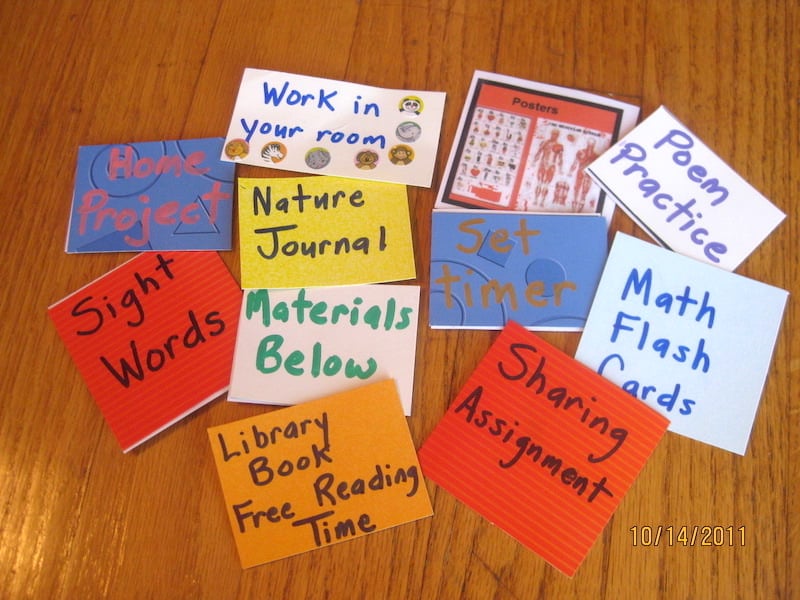 As you’ll see in the picture, I’ve made a number of custom labels that I use so that my students know exactly what they are expected to do, even before they’ve looked in the box. I’ve made simple labels for those repetitive study areas on cardstock with a Velcro back. Some of the labels I use are: Nature Journal, Poem Practice, Library Book Free Reading Time, Math Flash Cards, Sharing Assignment, and Home Project to name a few. This way the student sees the label and knows what’s expected of him or her. If my children need further instruction (about any specifics with an assignment), I include those specifics on a 3X5 card inside the box.
As you’ll see in the picture, I’ve made a number of custom labels that I use so that my students know exactly what they are expected to do, even before they’ve looked in the box. I’ve made simple labels for those repetitive study areas on cardstock with a Velcro back. Some of the labels I use are: Nature Journal, Poem Practice, Library Book Free Reading Time, Math Flash Cards, Sharing Assignment, and Home Project to name a few. This way the student sees the label and knows what’s expected of him or her. If my children need further instruction (about any specifics with an assignment), I include those specifics on a 3X5 card inside the box.
The noticeable change I have seen is that my children very rarely ask me what they need to do. The label communicates it first and, if needed, the 3X5 card drills down into the details of the assignment. Sue Patrick, creator of the Workbox System, says if your student doesn’t understand the assignment it’s not because the student is lazy or lacking intelligence, instead it’s because the teacher (you and I) hasn’t presented the assignment in a way the student can fully understand.
Improving communication with my kids during our homeschool days has been transformational for our family.
Read this Workbox System post from Homeschool Creations to learn more about how it works, and for the full explanation of how to use the system and all of Sue Patrick’s helpful ideas (she has many!), you can purchase her Workbox System: A User Guide, free on KindleUnlimited, or you can purchase and download an ebook version of it on her website (note: the user guide does contain Christian content, as the author shares her story and experience). And of course, for more information check out Sue Patrick’s website.
If this is the first time you’ve heard of the Workbox System, it may be a lot to take in. But if you desire more structure, clearer communication, and more efficient progress throughout your home day, this method is worth a try. We aren’t affiliated with Sue Patrick in any way, but from one group of homeschooling parents to another, we love sharing ideas and methods that have worked! Though it may not be the right fit for everyone, many families have found increased organization, independence, and peace in the home after implementing this system, or a modified version of it.
Here are a few more photos showing how different families created a version of the physical boxes to use with this system—note that you can create your own cute labels, put an older child’s rack up high to keep it out of a toddler’s reach, and adapt other storage bins to use with this method: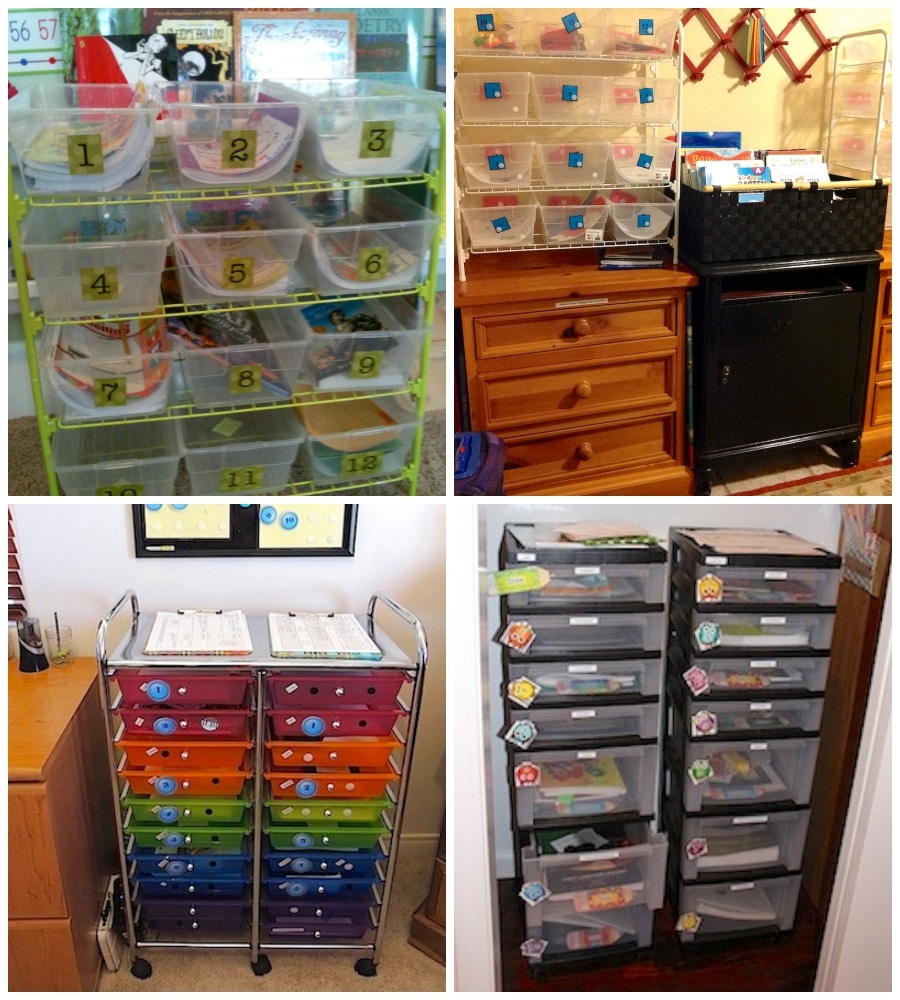
We hope this is helpful in helping you organize your homeschool space, let us know in the comments below if have questions or have tried the workbox system yourself!
